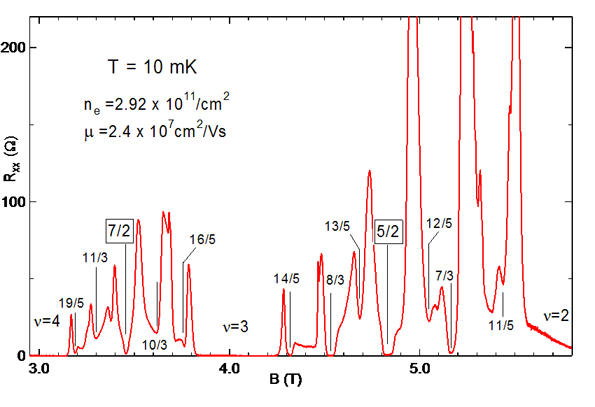
Temperature is effectively a measure of energy contained in an isolated system. When the temperature and thus energy content of a system is lowered toward absolute zero (0 K or -460 F) the weaker interactions within the system can become dominant and the system may often display interesting new behavior. Research in low temperatures has lead to many exciting discoveries in condensed matter and atomic physics, such as superconductivity, superfluidity, nuclear magnetic ordering and Bose-Einstein condensation. The quantum and fractional quantum Hall effects can also only be observed at low temperatures, but additionally they require the presence of a magnetic field. The lower the temperature the more ‘pure’ these phenomena become, thus motivating the development of experimental techniques to push the boundaries closer to the absolute zero.
Ultra-low temperatures in the milliKelvin-range can be realized by utilizing the exotic properties of the two helium-isotopes, He-4 and He-3. A dilution refrigerator works along the same basic principles as a household fridge, but is technically much more involved.
Temperatures below the 2 mK cooling limit of a dilution refrigerator are achieved by a technique known as adiabatic nuclear demagnetization. This process, first established already in the 1950’s uses the magnetic moment of nuclei in a suitable isolated system to reduce the entropy and thus temperature of a demagnetizaton stage. Very low temperatures can be achieved by this method and it has been successfully used to cool electron systems close to 1 microKelvin or alternatively nuclear spin systems to record low temperatures of a 100 pK.
A completely different approach is used for cooling the gaseous Bose-Einstein condensates, combining innovative methods of laser- and evaporative-cooling.
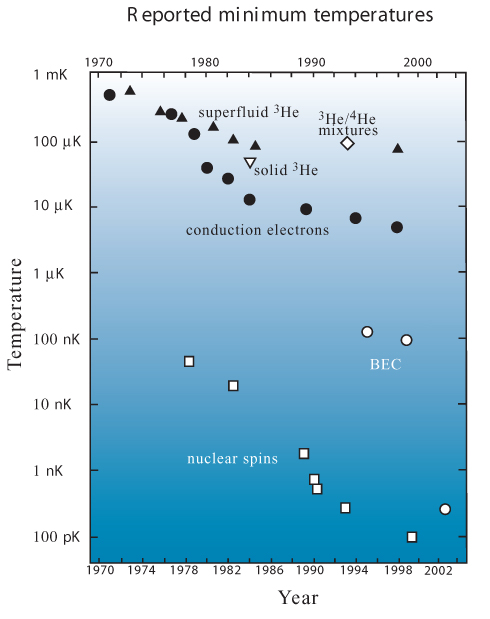
Experimental setup
The main component of our ultra-low temperature cryostat is a model-1000 dilution refrigerator from Oxford Instruments. It’s one of the biggest dilution units manufactured and capable of high circulating flows and high cooling power in the milliKelvin regime. The minimum temperature of the unit is around 6-7 mK. The dilution unit is used to cool a large high purity copper demagnetization stage, housed inside a 9 Tesla superconducting magnet. Below the demagnetization magnet we have another powerful superconducting magnet to provide the conditions required for studying electron transport in 2 dimensions. The sample magnet has a 2” bore and is capable of producing a 14 Tesla field.
The demagnetization stage was machined from high-purity copper (99.999%). It has a cylindrical shape with a diameter of 56 mm and length of 600 mm. Thin slits were cut along the longitudinal axis of the stage by a spark cutter to reduce the eddy-currents during sweeping of the external magnet field. The total mass of the stage is about 13 kg. After machining the stage was annealed in order to reduce the effect of trace magnetic impurities and to improve thermal conductivity. The demag-stage is operated by a 9 T superconducting coil.
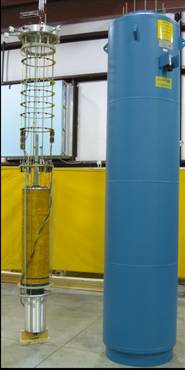
Fig. 1. Dewar and 2-stage magnet assembly (demag and sample magnets).
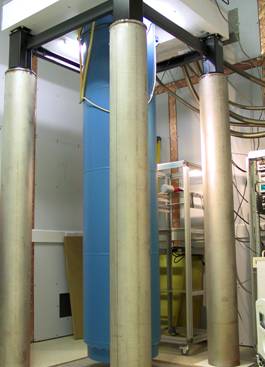
Fig. 2. System during operation.
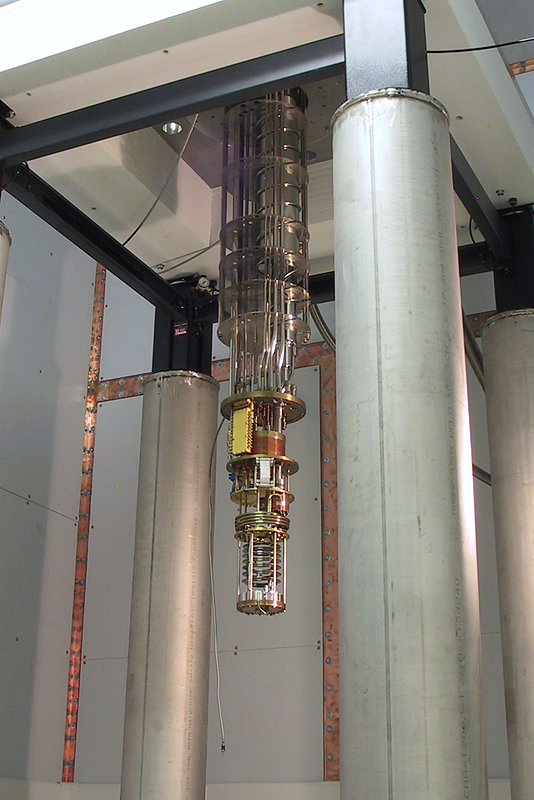
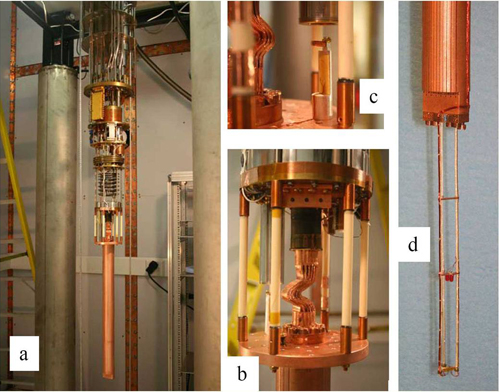
Fig. 3. (a) The Oxford model 1000 dilution refrigerator and the copper demagnetization stage assembled in the system, (b) Aluminum heatswitch, (c) Platinum NMR thermometer, (d) Sample holder assembly.
The demag-stage is mounted below the mixing chamber of the Oxford dilution unit by 6 support rods made from Al2O3-tube (Fig. 3a). Al2O3 has very low thermal conductivity at low temperatures and isolates the copper-stage well from the dilution unit. The thermal path to the copper-stage is controlled by a superconducting heat-switch (Fig. 3b). The superconducting material used in the switch is aluminum, which has a very high switching ratio 1600 T –2 (ratio between normal state and sc-state thermal conductivity). The thin copper-foils are soft and provide a flexible section between the demag-stage and dilution unit to allow for a perfect fit when mounting the assembly. The heatswitch Cu-parts were annealed similarly as the main stage. The aluminum section consists of 7 thin foils, 0.25 mm thickness, inserted into narrow slits cut in the Cu-parts and joined by diffusion welding. The switch is operated between the normal and sc-states by a small superconducting coil surrounding it.
Temperature of the demag-stage is monitored by a platinum NMR (nuclear magnetic resonance) thermometer (Fig. 3c). Platinum is a good choice for NMR-thermometry because of two main reasons; the Korringa constant is small (30 msK) so the spin-lattice relaxation is quick and spin-spin relaxation, t2, is long (~1 ms) making the measurement relatively easy. The platinum probe is a wire-brush consisting of ~2000 wires, 0.001” in diameter. It is clamped to a silver-foot that is mounted on the top-flange of the demag-stage. The static coil for the pulsed-NMR measurement is a small superconduncting coil mounted to the bottom of the mixing chamber. The rf-coil for the NMR signal is wound around the Pt-brush from 25 mm Cu-wire and has ~1000 turns. The Pt-NMR thermometer is operated by specifically designed electronics, PLM-5 (RV elektroniikka). The Pt-NMR thermometer was calibrated against the Co-60 NO (nuclear orientation) thermometer between 8 to 20 mK. The Pt-NMR shows excellent linearity over this range, as expected from the Curie-law, M0 = C/T .
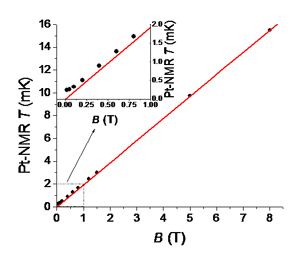
Fig. 4. The measured copper temperature versus demagnetization field is shown. The line shows ideal adiabatic relation, B/T = Bi/Ti.
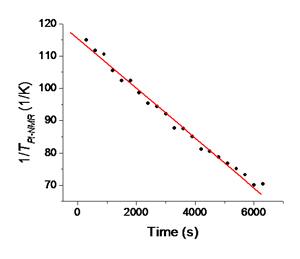
Fig. 5. Heatleak to the demag-stage at 100 mT. The linear fit gives a value of 21 nW.
The demag-stage displays close to ideal adiabatic performance during demagnization as shown in Fig. 4. The stage was precooled in an 8 T field down to 15.5 mK with the dilution unit in 18 hours. After thermally isolating the stage by opening the heatswitch, the copper was demagnetized down to 20 mT As seen from Fig. 4 (inset) the Pt-NMR thermometer starts to decouple thermally from the copper-stage below about 0.5 mK. The minimum temperature indicated by the thermometer was 0.24 mK at 20 mT.
The heatleak to the demag-stage was measured by monitoring the temperature increase at a 100 mT field (Fig. 5). The resulting value of 21 nW is very reasonable for a stage this large after only 2 days from cooling down the system. At very low temperatures the relaxation rate of some heatleak sources, such as impurities and non-metallic materials, can be very slow, on the order of days/weeks, and the background heatleak should further diminish in a longer cooldown cycle. Thus it can be concluded that the performance of the demag-stage is very good. The Pt-NMR thermometer also performs adequately; the decoupling below 0.5 mK is not an issue at this point as the relevant temperature range for the planned experiments is 1-10 mK.
The sample-holder for the semiconductor samples (Fig. 3d) mounts on the bottom of the demag-stage. It consists of 3 silver and a triangular sample-flange. The sample wiring is a bundle of 18 wires (8 wires each for 2 samples and 2 wires for operating the light-emitting diodes for sample illumination at low temperature). At the mixing chamber the wires go through a powder-filter block for improved thermal anchoring and for filtering out high frequency noise. Wires are anchored all along the demag-stage by attaching the bundle with varnish on the side of the copper.
After mounting the sample on the silver flange with N grease the measurement contacts are provided by soldering the gold bonding wires of the samples directly to the ends of the Cu-wires. This should ensure good thermal anchoring of the contacts to the demag-stage.
Dr. Rui-Rui Du
rrd@rice.edu
Rice University Physics & Astronomy
Dell Butcher Hall Rm. 170
1900 Rice Blvd. Ent. 20
Houston, TX 77005
>Office Phone: 1-713-348-5780
>Lab Phone/Fax: 1-713-348-5719
Department of Energy
Basic Energy Science
Experimental Condensed Matter Physics

